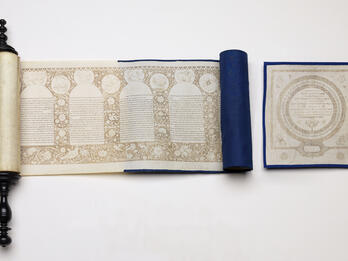Description of the Spanish and Portuguese Synagogue (Esnoga) in Amsterdam
Daniel Levi de Barrios
ca. 1675
On the south it is separated from the synagogue of the Polish and German Jews by a branch of the River Amstel; on the west it faces the opulent Casa de los lázaros [hospice for the poor]; on the north it opens upon the large street of the Jewish district; and on the east it touches the site of the houses that are on another branch of the Amstel…
Creator Bio
Daniel Levi de Barrios
A poet and playwright, Daniel Levi (Miguel) de Barrios was considered the greatest poet among Western Sephardic Jews. He was born in Montilla, Andalucía, to a family of New Christians. In the 1650s, he returned to Judaism in Livorno. For some time, however, he lived as a Catholic in Brussels, which was under Spanish rule, and he received the rank of captain in the Spanish army. In 1662, de Barrios settled in Amsterdam but occasionally traveled to Brussels, despite the prohibition imposed by the Sephardic Jewish community. He also became a follower of Shabbetai Tzvi. Some of de Barrios’s books were published in Brussels under the name Miguel Barrios, his Christian name, to the dismay of the syndics of the Amsterdam Jewish community. His poetry was influenced by the Spanish Baroque style. Among his writings are historical works about the Sephardic community of Amsterdam, with attention to its personalities and institutions.
Related Guide
Early Modern Rabbis and Intellectuals on the Move
Carrying books and knowledge, itinerant rabbis and scholars traveled between communities, facilitating cultural exchange.
Related Guide
Early Modern Religious Practices
Early modern Jews both preserved tradition and innovated, Documents and legal texts reveal rich details about synagogue life, marriage, family relations, and death rituals.
You may also like
Regulation: On Preaching



